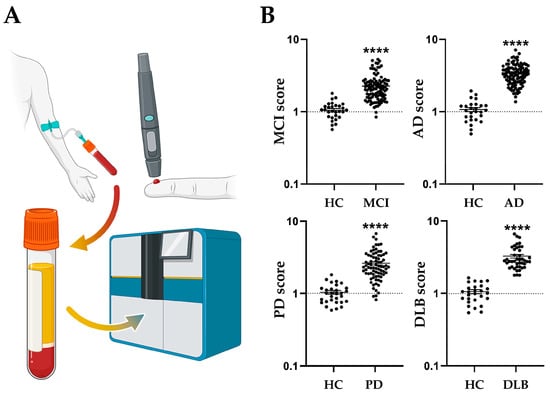Parkinson’s disease is a neurodegenerative condition characterized by motor dysfunction resulting from the degeneration of dopamine-producing neurons in the midbrain. This dopamine deficiency gives rise to a spectrum of movement-related symptoms, including tremors, rigidity, and bradykinesia. While the precise etiology of Parkinson’s disease remains elusive, genetic mutations, protein aggregation, inflammatory processes, and oxidative stress are believed to contribute to its development. In this context, fatty acid-binding proteins (FABPs) in the central nervous system, FABP3, FABP5, and FABP7, impact α-synuclein aggregation, neurotoxicity, and neuroinflammation. These FABPs accumulate in mitochondria during neurodegeneration, disrupting their membrane potential and homeostasis. In particular, FABP3, abundant in nigrostriatal dopaminergic neurons, is responsible for α-synuclein propagation into neurons and intracellular accumulation, affecting the loss of mesencephalic tyrosine hydroxylase protein, a rate-limiting enzyme of dopamine biosynthesis.
1. Physiological Function of FABP and Involvement in Neurodegenerative Diseases
Fatty acids perform a variety of physiological functions in the body, serving as a source of energy for internal combustion, a major component of cell membranes, and a regulator of inflammatory responses. Excessive intake of fatty acids contributes to energy overload, obesity, and risk of brain inflammation. Fatty acids include saturated fatty acids; unsaturated fatty acids, which include monounsaturated and polyunsaturated fatty acids; and trans fatty acids. Some of these polyunsaturated fatty acids cannot be synthesized in the animal’s body and must be obtained from the diet. An excess of or deficiency in polyunsaturated fatty acids are associated with various functional disorders, neurological symptoms, and an increased risk of disease pathogenesis. Polyunsaturated fatty acids can be classified into omega-3 fatty acids, represented by docosahexaenoic acid (DHA) and eicosapentaenoic acid (EPA), and omega-6 fatty acids, which are metabolized into linoleic acid and arachidonic acid.
Because fatty acids are hydrophobic, they require carrier proteins to transport them to intracellular organelles, and FABPs are responsible for this physiological function [
6,
7,
8,
9]. FABP is a protein consisting of approximately 130 amino acid residues, and nine isoforms have been identified in humans [
10,
11]. Each of these isoforms is known to have some specificity in its expression distribution (
Table 1). Three of these isoforms, FABP3, FABP5, and FABP7, are expressed in the nervous system [
12,
13,
14,
15]. FABP3, which was first identified in the heart [
16,
17], is abundantly expressed in mature neurons from the postnatal to the adult stage [
14]. In contrast, FABP5 and FABP7 are maximally expressed in the fetus and neonate, during which time they are expressed in glial and neural stem cells [
14,
18,
19]. FABP3 has a high affinity for n-6 polyunsaturated fatty acids such as arachidonic acid, FABP5 has a high affinity for saturated fatty acids such as stearic acid and palmitic acid, and FABP7 has a high affinity for n-3 polyunsaturated fatty acids such as DHA [
20,
21,
22].
Polyunsaturated fatty acid itself affects the toxic expression of α-synuclein, the pathogenic protein of Parkinson’s disease. Previous reports indicate that polyunsaturated fatty acids bind to α-synuclein and promote oligomer formation [
23,
24,
25]. The exposure of cultured mesencephalic neurons to polyunsaturated fatty acids increased α-synuclein oligomer levels [
25]. In addition, when mice expressing A53T, a representative mutant family line of α-synuclein in familial Parkinson’s disease, were fed a DHA-containing diet, low concentrations of α-synuclein suppressed neuronal accumulation and toxic expression. In contrast, high concentrations of DHA increased intracellular accumulation of soluble and insoluble α-synuclein and neuronal injury [
26]. In humans, fatty acids have also been implicated in the pathogenesis of Lewy body disease, and α-synuclein oligomers in the lipid fraction are detected in autopsy brains of Parkinson’s disease and Lewy body dementia patients but not in healthy subjects [
25]. Furthermore, a higher intake of arachidonic acid, an omega-6 polyunsaturated fatty acid, has been suggested to increase the risk of Parkinson’s disease pathogenesis [
27].
Furthermore, FABPs have pathogenic impacts and the potential for predictive biomarkers on various diseases, including brain injury and neurodegenerative disorders. FABP3 and FABP7 exhibit distinct distribution patterns within brain tissues, with FABP3 displaying notably higher concentrations in brain injury [
28]. Elevated serum levels of FABP7 were observed in patients with Alzheimer’s disease, Parkinson’s disease, and other cognitive disorders [
4]. In addition, FABP3 expression in the substantia nigra is known to be increased in autopsy brains of Parkinson’s disease patients [
29]. In this context, FABP3 co-localizes with phosphorylated α-synuclein in Lewy bodies [
30]. Serum FABP3 levels are increased in patients with Parkinson’s disease and dementia with Lewy bodies compared to healthy controls [
3,
31]. In addition, serum FABP3 was elevated in dementia with Lewy bodies and Parkinson’s disease with dementia, compared to non-dementia controls [
2,
32]. These clinical findings suggest that FABP3 may be involved in the pathogenesis of Lewy body diseases, including Parkinson’s disease. Based on these insights, the following chapters will describe the characteristics of Parkinson’s disease, the selective degeneration of dopaminergic neurons, and the pathogenic impact of FABPs in the disease.
Table 1. Tissue distribution and expressed cell types of the fatty acid-binding protein (FABP) subfamilies.
This entry is adapted from the peer-reviewed paper 10.3390/ijms242317037

 Encyclopedia
Encyclopedia
